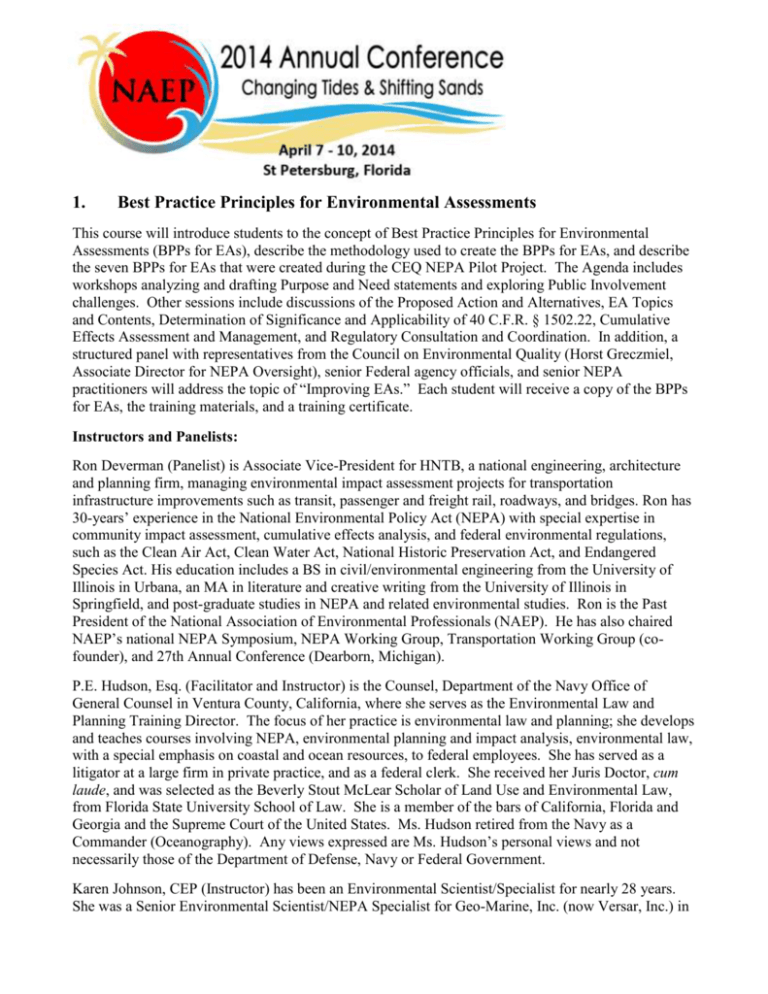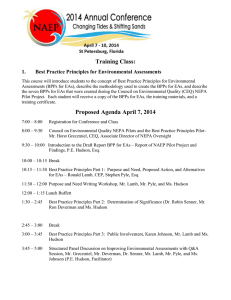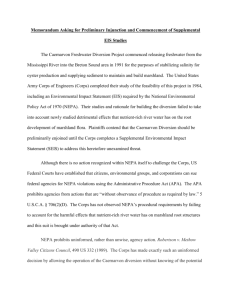Best Practice Principles for Environmental Assessments
advertisement

1. Best Practice Principles for Environmental Assessments This course will introduce students to the concept of Best Practice Principles for Environmental Assessments (BPPs for EAs), describe the methodology used to create the BPPs for EAs, and describe the seven BPPs for EAs that were created during the CEQ NEPA Pilot Project. The Agenda includes workshops analyzing and drafting Purpose and Need statements and exploring Public Involvement challenges. Other sessions include discussions of the Proposed Action and Alternatives, EA Topics and Contents, Determination of Significance and Applicability of 40 C.F.R. § 1502.22, Cumulative Effects Assessment and Management, and Regulatory Consultation and Coordination. In addition, a structured panel with representatives from the Council on Environmental Quality (Horst Greczmiel, Associate Director for NEPA Oversight), senior Federal agency officials, and senior NEPA practitioners will address the topic of “Improving EAs.” Each student will receive a copy of the BPPs for EAs, the training materials, and a training certificate. Instructors and Panelists: Ron Deverman (Panelist) is Associate Vice-President for HNTB, a national engineering, architecture and planning firm, managing environmental impact assessment projects for transportation infrastructure improvements such as transit, passenger and freight rail, roadways, and bridges. Ron has 30-years’ experience in the National Environmental Policy Act (NEPA) with special expertise in community impact assessment, cumulative effects analysis, and federal environmental regulations, such as the Clean Air Act, Clean Water Act, National Historic Preservation Act, and Endangered Species Act. His education includes a BS in civil/environmental engineering from the University of Illinois in Urbana, an MA in literature and creative writing from the University of Illinois in Springfield, and post-graduate studies in NEPA and related environmental studies. Ron is the Past President of the National Association of Environmental Professionals (NAEP). He has also chaired NAEP’s national NEPA Symposium, NEPA Working Group, Transportation Working Group (cofounder), and 27th Annual Conference (Dearborn, Michigan). P.E. Hudson, Esq. (Facilitator and Instructor) is the Counsel, Department of the Navy Office of General Counsel in Ventura County, California, where she serves as the Environmental Law and Planning Training Director. The focus of her practice is environmental law and planning; she develops and teaches courses involving NEPA, environmental planning and impact analysis, environmental law, with a special emphasis on coastal and ocean resources, to federal employees. She has served as a litigator at a large firm in private practice, and as a federal clerk. She received her Juris Doctor, cum laude, and was selected as the Beverly Stout McLear Scholar of Land Use and Environmental Law, from Florida State University School of Law. She is a member of the bars of California, Florida and Georgia and the Supreme Court of the United States. Ms. Hudson retired from the Navy as a Commander (Oceanography). Any views expressed are Ms. Hudson’s personal views and not necessarily those of the Department of Defense, Navy or Federal Government. Karen Johnson, CEP (Instructor) has been an Environmental Scientist/Specialist for nearly 28 years. She was a Senior Environmental Scientist/NEPA Specialist for Geo-Marine, Inc. (now Versar, Inc.) in Plano, TX, from 2004 to 2013. Her primary responsibilities included managing NEPA documentation projects for numerous Federal agencies under the Departments of Defense, Agriculture, Energy and Transportation at both the individual project and the programmatic level. She also has completed more than 20 Environmental Site Assessments (Phase Is) or Environmental Baseline Surveys for both private and Federal clients. In 2007, she accepted an assignment to spend a year in Guam providing inhouse NEPA support for NAVFAC Marianas, which she found both professionally and personally stimulating. Prior to her work with Geo-Marine, Ms. Johnson spent 12 years with Ecology and Environment, Inc. in San Francisco, CA, initially working under contract with the USEPA to do Superfund site assessments, then staffing and managing CEQA and NEPA projects. Her career started by spending five years with the US Geological Survey Water Resources Division in Sacramento, CA. Ronald E. Lamb, CEP (Instructor and Panelist) is an environmental program manager and senior project manager with more than 25 years of experience in NEPA compliance, environmental compliance and policy, public involvement and community relations, waste management and pollution prevention; litigation support; and issue management. He is a NEPA Specialist at Headquarters, U.S. Marine Corps, where he reviews the adequacy of EISs on USMC actions, serves on the Headquarters USMC Environmental Impact Review Board, and represents the USMC to the President’s Council on Environmental Quality (CEQ), other Department of Defense services, and other Federal agencies. Ron is co-chair of the NAEP NEPA Practice and served two-consecutive terms on the Board of Directors. Previously, he was a Vice President and NEPA Program Manager for HDR|e2M. In this role, he had organizational oversight of all HDR|e2M NEPA activities, client, staff supervision and development, and program/project management quality assurance/quality control (QA/QC). Ron has personally managed the preparation of dozens of EAs and 14 EISs for the Department of Homeland Security (DHS) Coast Guard (USCG) and Customs and Border Protection (CBP), U.S. Air Force, Bureau of Land Management (BLM), General Services Administration, National Park Service, U.S. Army Corps of Engineers (USACE), and NASA. Stephen Pyle, Esq. (Instructor), is a Senior NEPA Project Manager at HDR Environmental, Operations, and Construction, Inc. Mr. Pyle has 14 years of experience within the environmental field and two years of legal/litigation experience. Mr. Pyle currently manages all aspects of NEPA projects, including EISs and EAs, for various Federal agencies. In addition to completing numerous EAs throughout his career, Mr. Pyle has successfully completed EISs for diverse Federal agencies including U.S. Coast Guard, National Park Service, U.S. Customs and Border Protection, and is currently completing a complicated EIS for the U.S. Air Force in the Mariana Islands region. Mr. Pyle has also conducted and taken part in a wide range of environmental compliance activities for Federal agencies related to hazardous waste management, storm water management, and natural resource management. In addition, he is experienced as a litigation clerk, paralegal, legal researcher and litigation attorney for two law firms. Mr. Pyle's legal experience includes general contract law, construction defects, mechanics lien law, oil and gas law, Federal Mine Safety and Health Administration law, and general litigation. Mr. Pyle has represented clients before Texas County and District Court judges. He is a licensed attorney, admitted to the State Bar of Texas. Dr. Robert Senner (Instructor) is a Principal with ARCADIS, a global engineering and environmental consulting firm, and is based in Anchorage, Alaska and Seattle, Washington. Dr. Senner has successfully managed and completed many environmental impact statements and environmental assessments, including NEPA, Washington State Environmental Policy Act (SEPA), and Environmental, Social, and Health Impact Assessment (ESHIA) programs. His clients and lead agencies have included most Federal agencies involved in energy, resource development, and transportation, corresponding state agencies, and major energy and engineering companies. He received his Ph.D. in Public Policy (Environmental Law and Economics) from The University of Texas at Austin, Lyndon B. Johnson School of Public Affairs. He also completed advanced studies in biology as a Nuffield Scholar at the University St. Andrews, served as a Royal Society Scholar at the Stazione Zoologica in Naples, and was a National Institute of Mental Health postdoctoral fellow at the California Institute of Technology. He received his Bachelor’s degree from Yale University, where he was a National Science Foundation Scholar. Dr. Senner was an original member of the team selected by the CEQ to conduct the Pilot Project on Best Practice Principles for NEPA EAs. He has published a number of peer-reviewed papers on improving NEPA EAs, cumulative effects assessment and management, and sustainability. 2. Digital Visualization Simulation Short Course/Symposium This day-long symposium targets visual resource specialists, public land managers, NEPA practitioners, and developers and their project planners/designers with a basic understanding of visualization technology used for project planning, design and visual impact assessment (VIA). The purpose of the training is to improve and expand upon our understanding to maximize the value and utility of visualizations for project planning and design purposes, as well as of what is required to produce defensible and accurate visualizations to support NEPA-related or state-specific documentation of anticipated impacts, regardless of jurisdiction. The symposium will have three parts. The first part will introduce design data review, scoping for the project and site reconnaissance/photography and the emergence of visualization tools with examples of good and bad simulations. The second part will address more technical aspects of computer modeling, adding materials and texture; view-matching and lighting/rendering; digital painting and compositing; animation and post production; and exhibit distribution and printing. The final part will be a panel discussion involving all instructors and audience in bringing visualization into the assessment process plus due diligence and participation issues. Speakers will include nationally- and internationallyrenown leaders in the field of visualization technology especially for VIAs prepared for large scale projects targeted for both private and federal public lands. Symposium Leaders/Instructors: Louise Kling, Environmental Planning Lead for the URS Land and Water Group, Portland Oregon Shawn Jackson, landscape architect and Visual specialist, Tetra Tech , Denver, Colorado John McCarty, Chief landscape Architect USDI Bureau of Land Management, Wash., DC James Palmer, PhD Distinguished Research Professor Emeritus SUNY/ESF and Scenic Consultants, Burlington, Vermont Rick Smardon PhD, SUNY Distinguished Service Professor, SUNY/ESF, Syracuse NY Edward Twiss, Truescape North American Operations Manager, New York, NY The Interrelation Between Listed Species and Invasive Species For many of us who work in the biological and ecological fields, the treatment of state and federally listed threatened and endangered species (listed species) is usually separated from the investigations into the quantification and eradication of invasive species. Even the definition of an invasive species can be a source of disagreement. Like weeds, the wrong species in the wrong habitat is a threat to everything around it, especially to many threatened or endangered species clinging to existence in small, scattered pockets of native habitat surrounded by cleared or impaired habitats. This training session will attempt to describe the most up to date research and findings concerning endangered species and how they have been affected by the introduction of invasive species. For example, the domestic cat is a definite threat to migratory songbirds, including many listed species and candidates for listing. Yet, is complete eradication an answer, or desirable, or even possible? An introduced rodent, the nutria, is munching its way through precious remaining patches of tidal wetlands; while an introduced insect, the emerald ash borer, has left swaths of dead trees through many upper Midwestern forests, and the introduced redbay ambrosia beetle threatens the redbay tree in Florida swamps. The Brazilian pepper has had its dire effects on the Florida Everglades and Big Cypress. Melaleuca quinquenervia, commonly called melaleuca or punk tree and a desirable tree in its native Australia, has not only crowded many native species out of south Florida habitats, it had fundamentally altered the hydrology of those habitats. Its effects may extend long distances from where it actually stands. Who knows what all of these invasive species has (or will) helped to push to extinction while enhancing the further establishment of invasive species? Is success in the Endangered Species Act solely related to numbers of individuals, or should it also hinge on the protection of habitats from invasive species and restoration of habitats degraded by invasive species? These questions and more will be addressed as our panel presents its findings and provide their recommendations for looking at these separate problems in a more integrated way. As part of what NAEP also does, we will also introduce the multidisciplinary aspect for addressing the problem and approaching the correct solution. We will try to look at how regulatory and political will can be increased to help restore badly degraded habitats and provide the tools for the reintroduction and proliferation of listed species, especially at the state level where financial support for this type of restoration can be very soft to non-existent. This is not strictly a Florida issue, it has national and international implications. The brilliant minds working to solve the problems should consider this as the first of its kind where we all can strive to figure a path for future progress and potential successes. Instructors: Paul Looney, CEP, CSE, PWS Paul has worked in the field of ecology for 24 years in different areas of emphasis. His primary area of expertise is coastal plant ecology. He is directly involved in ecological field work as part of his daily professional life through wetland delineations, threatened and endangered species surveys, coastal ecosystem restoration, and NEPA studies. The issue of invasive species has been of great interest since attending a symposium sponsored by the state of Florida in 1994. Making the connection between listed species and invasive species has been long in developing, but it is of great interest to him to determine what is being done in this field and possibly establish more of a natural resources emphasis into NAEP. Peyton Doub, CEP, PWS Peyton has more than 25 years experience as a terrestrial ecologist and wetland scientist, working for nearly 20 years as an environmental consultant and for the last 5 years for the Nuclear Regulatory Commission. He has performed numerous wetland delineations, forest surveys, ecological risk assessments, and wetland mitigation plans in various regions of the United States, especially the midAtlantic and southeastern states, including Florida. He has contributed to numerous environmental assessments (EAs) and environmental impact statements (EISs) by the Air Force, Navy, Coast Guard, Forest Service, Department of Energy, and Nuclear Regulatory Commission. He has monitored several wetland mitigation projects in the eastern United States for invasive plants and other problems and in 2003 contributed to an EA for a program of non-native invasive plant control in Michigan. Since 2008, Peyton has contributed to the environmental review of 8 applications for new nuclear reactors (including 2 applications for new reactors in Florida), including the preparation of environmental impact statements (EISs) for each. Part of his review has been contributing to biological assessments (BAs) addressing possible impacts to threatened and endangered species. In 2012, Peyton authored a book published by CRC Press titled The Endangered Species Act: History, Implementation, Successes, and Controversies. Peyton is a Professional Wetland Scientist (PWS) and Certified Environmental Professional (CEP) and serves on the Board of Trustees for the Academy of Board Certified Environmental Professionals.






